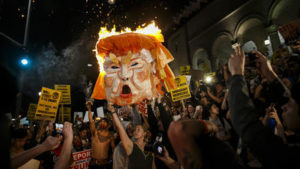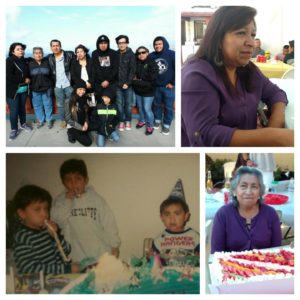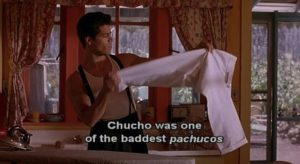 Altars are a very important part of Día De Los Muertos celebrations. Altars serve as the way that those who are alive pay respect to their loved ones who have passed away. These Día De Los Muertos altars are vary from family to family. However, most of them include items that those that the altar is dedicated to enjoyed. I created an altar for my Grandfather on my Mom’s side and my Grandmother on my Dad’s side. The altar I created was for Amado Geronimo and Emilia Torres. I set up the altar in the living room of my apartment. It is set up right in front of the front door so whenever someone walks in the first thing they see is the altar. I created the altar for my Grandfather and my Grandmother because I feel they are the people who shaped my parents.
Altars are a very important part of Día De Los Muertos celebrations. Altars serve as the way that those who are alive pay respect to their loved ones who have passed away. These Día De Los Muertos altars are vary from family to family. However, most of them include items that those that the altar is dedicated to enjoyed. I created an altar for my Grandfather on my Mom’s side and my Grandmother on my Dad’s side. The altar I created was for Amado Geronimo and Emilia Torres. I set up the altar in the living room of my apartment. It is set up right in front of the front door so whenever someone walks in the first thing they see is the altar. I created the altar for my Grandfather and my Grandmother because I feel they are the people who shaped my parents.
My Grandfather passed away when Mom was a teenager. However, my Mom always talks about my Grandfather. She tells me stories of how much of great man he was. When she describes how much of a great man he was my Mom tells me stories of how he always took care of his family. My Grandfather always helped struggling family members no matter if it meant that they had to work harder. For example, at an early age my Grandfather let one of my Mom’s cousins stay with them because she was facing many family problems. Without hesitation my Grandfather let her stay with them and she basically became like a sister to my Mom. I believe this story demonstrates that my Grandfather was a great man who really cared for his family. My Grandfather believed that he needed to keep his family united and help everyone out when they are struggling. She also tells me stories of the different lessons that my Grandfather taught her. One of the stories my Mom has told me involves my Grandfather taking her out to work in the fields. My Mom tells me that my Grandfather taught her how to pick fruit and do many labor related jobs. This served as a way to show her that she is capable of doing any job. My Grandfather taught my Mom how to do jobs that are typically taught to only boys and men. I believe that this helped her understand that she can do anything a man can do no matter how hard the job is. By doing this my Grandfather was teaching my Mom how to fight against patriarchy that is found in society. My Mom grew up with the idea that a woman can do the same work that a man can do. This is important because my Grandfather wasn’t pushing the patriarchal ideology found throughout Mexico on his daughter. By having her work the same jobs as the boys, my Mom was able to fight against the patriarchy and machismo of the time. It is very noticeable that he had a great impact on her life while he was alive. My Grandfather also had an impact on my Mom’s life after he passed away. My Grandfather passed away while my Mom was a teenager and this really affected her life. Due to this my Mom learned to become independent. The lessons my Mom was taught by my Grandfather served as a way to make her more independent. Without knowing it by taking my Mom out to do physical jobs, my Grandfather was helping my Mom grow to be much more independent woman. My Mom’s life was changed drastically with the death of my Grandfather but it helped her become more independent.
I also chose to dedicate this altar to my Grandmother because she played a huge role in shaping my Dad’s life. While my Dad was growing up, my Grandmother was the one who ran the household. She took care of all the children and worked hard to provide for them. My Grandfather spent most of his time in the United States working so he wasn’t around for long periods of time. Due to my Dad’s father being gone, my Grandmother had to take care of the family. My Dad tells me stories of the struggles that they had to overcome while my Grandfather was in the United States. My Grandfather worked in the United States but never sent any money back to Mexico. This meant that my Grandmother had to work extra hard in order to serve. My Dad tells me how she would do many things in order to bring money home. One of the things she did was make bread. She worked the ovens and made bread to sell in order to survive. The hard work that my Grandmother did shaped my father by teaching him to always work hard. My Grandmother is the reason why my Dad has such a strong work ethic. My Dad works very hard and never does anything without trying his hardest. My Dad tells me stories about the different task my Grandmother would make him do and it is noticeable that it shaped him. For example, my Dad always tells me the story of the chores he would have to do everyday before going to school. He says he would wake up early and walk about a mile to get water and bring it back to the house. He would then have to milk the cows. The final thing he would have to do before he was able to go to school he had to wake up his younger brother. This type of discipline that my Dad was taught really shaped him and his work ethic. My Grandmother taught my Dad that working hard and providing for your family is the most important aspect of life. This is an idea that my Dad has been teaching me for years. He always tells me that no matter what you’re doing you always need to give it a hundred percent. Throughout my life I have seen my Dad work extremely hard to provide for my family. No matter what my Dad always provides what is needed in my family. I know that he was taught to be this way by my Grandmother and I know he appreciate everything she did. My Grandmother passed away 4 years ago. My Dad was not able to see his mother before her death. Due to internalized pain, my Dad doesn’t really bring up stories of my Grandmother anymore. However, when I told my Dad that I wanted to create the altar for both my Mom’s father and his mother he was overjoyed. He went and found a picture for the altar and told me about things she enjoyed. I could tell that my Dad was happy that I was paying my respects to my Grandmother. I felt it was necessary to pay respect to the woman who shaped the man who has influenced me the most in my life. I saw this opportunity as a way to let her know that I appreciate her impact on my life.
When creating the alter I included a variety of items. The first thing I included were pictures of my Grandfather and my Grandmother. The picture were used to show who the altar was dedicated to. The second item I included were candles. I used white candles to pay respect to my Grandmother and Grandfather. My Mom told me that the candles are used as way to guide my Grandmother and Grandfather. The light of the candle is the way the spirit find their way through the darkness. Without the candles, the spirits can get lost and not find their way to their altars. I also included two shots of mezcal. My Mom told me that my Grandfather’s favorite drink was mezcal. Since the alter is supposed to include things enjoyed in life I decided to include itt. I also included some apples to the alta. I included apples because both my Grandfather and Grandmother enjoyed apples. My Mom also told me to include apples because it always good to include fruit in Día de Los Muertos altars The final item I included in my altar was Pan de Muertos. However, I did not use the bread that they sell at the store. In my altar I used regional bread. The bread that I used is bread that is used for altars in Guerrero, Mexico. Both my Grandfather and Grandmother were from Guerrero. I wanted to include the Pan de Muertos that was from their homeland. It serves as a way to pay respect to them and to their land. I also wanted to include the bread because my Grandmother was a bread maker while she was alive. My Dad always talks about how she would make some of the best pan in the pueblo. I wanted to include the bread to pay respect to this aspect of my Grandmother’s life. Those were the items that were included in the altar that I dedicated to my Grandfather and Grandmother.
My Grandmother was a very important part of my Dad’s life. She was the one who took care of the family. She worked very hard to provide for her children. My Grandfather was always in and out of the picture. He would leave for long periods of time and go work in the United States. This would lead to my Grandmother working to provide for my Dad and his siblings. My Grandmother was part of a culture with “institutionalized heterosexism, inbred machismo, and a lack of cohesive national political strategy” (Rodríguez,8). This culture that she was a part of basically told her that she needed My Grandfather in the picture in order to survive. However, my Grandmother was providing for her family without the help of a man. My Grandmother was fighting patriarchy without even knowing it. By being the leader of the household my Grandmother served as the head of the family. She was in the role that a man is supposed to be in, according to traditional Mexican family structure. She was not a man but was providing for her family the way a man is supposed according to a culture of machismo and patriarchy.. My Grandmother went against the idea that a man is needed in order for a family to survive. She took the role of the head of household and showed that women are able to provide for a family. This idea was fighting the patriarchy that is found in traditional Mexican families. My Grandmother was definitely an inspiration for my Dad. Growing up with my Grandmother working hard to provide showed him that anything can be overcome. My Dad and his siblings faced a lot of problems while my Grandfather was working in the United States. However, my Grandmother did not allow this to stop her from providing and overcoming. I think that my Grandmother’s work ethic showed my Dad that hard work and less to the overcoming of any problem. My Grandmother also served as an inspiration for my aunts. All of my aunts are very hard working and help provide for their household. My aunt Carina is the one I believe she played a big role in molding. My aunt Carina is very independent and does not let her husband provide everything for her. Not only does she work with her husband, who is a gardener, she also does all the housework and even takes care of her grandchildren. Through her actions it is definitely evident that my Grandmother and her way of taking care of her family influenced her. My Grandmother really impacted the life of my Dad and his siblings by showing them that a woman can provide for her family even in a patriarchal society.
Like my Grandmother, my Grandfather was a very important part of my Mom’s life. My Grandfather is the person who impacted all of my family members on my Mom’s side. While many of my younger family members, myself included, never met my Grandfather he still had an impact on our lives. My Grandfather was the one who shaped all my uncles and aunts. He taught them the meaning of hard work. While alive, my Grandfather worked hard to provide for his family. My Grandfather also instilled the idea that family is important. Like Richard T. Rodríguez explains in his book Next of Kin, Mexican families are known for “embracing a family principle as a modality of unity” (98). This is what my Grandfather was trying to teach his children. He taught everyone that family is the most important thing and that it was a way to keep them united. I have heard stories from my extended family members about how great of a man my Grandfather was. My Grandfather not only took care of his children and wife, he also tried to take care of any of his family members who were struggling. This shows that my Grandfather believed that a family had to stay united and help each other out even if it means working harder. My Grandfather really believed in unity within the family. My Grandfather’s early death also had a huge impact on my family. His death lead to my family coming together. While it is very unfortunate that he passed away at a young age, his death lead to my family always staying together. All my family members are united and always come together. My Grandfather and Grandmother had an impact on both my parents and my whole family.






 The readings of this week focus on the representation of Chicano/a families in the media. The readings talk about how Chicano/a families are portrayed on television and in movies. Of the two readings I found Chapter 2 “Shooting the Patriarch” of Next of Kin by Richard T. Rodríguez to be the one to catch my interest the most. I found this reading to be interesting because I felt there was an emphasis on recent representations of the Chicano/a family.
The readings of this week focus on the representation of Chicano/a families in the media. The readings talk about how Chicano/a families are portrayed on television and in movies. Of the two readings I found Chapter 2 “Shooting the Patriarch” of Next of Kin by Richard T. Rodríguez to be the one to catch my interest the most. I found this reading to be interesting because I felt there was an emphasis on recent representations of the Chicano/a family.